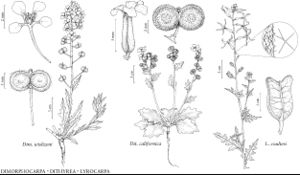Lyrocarpa coulteri
London J. Bot. 4: 76, plate 4. 1845.
Plants suffrutescent; moderately to densely pubescent throughout. Stems straw-colored, woody (at least proximally), many-branched, (2–)3–9(–11) dm. Cauline leaves: petiole 0.5–2.5(–4) cm (shorter distally); blades lanceolate, oblanceolate, or ovate in outline, (1–)2–9(–12) cm × (5–)10–50(–70) mm (smaller, less divided distally), base attenuate to cuneate, or truncate to hastate, margins usually pinnatisect to pinnatifid, or runcinate to dentate, rarely repand, teeth and lobes apiculate or not, sparsely to densely pubescent, nearly canescent. Fruiting pedicels divaricate to ascending or, rarely, reflexed, 2–7(–11) mm. Flowers: sepals (6–)8–10(–11) × 1–1.5 mm; petals (twisted with age), (13–)16–25 × 1–3 mm, claw 7–12 mm; filaments 4–6 mm; anthers 2.7–3.5 mm. Fruits (8–)10–25 × (8–)10–16 mm, base obtuse, apex deeply emarginate, (sinus to 8 mm deep), retuse, or truncate; style obsolete or to 0.5 mm. Seeds 2–3 mm diam. 2n = 36, 42.
Phenology: Flowering late Sep-mid Apr.
Habitat: Gravelly or rocky slopes, desert washes, dry streambeds, sandy plains, shady ravines, granitic hills, mesa slopes, thorn scrub, stony ridges, gravelly arroyo beds, in open sun or under shrubs
Elevation: 0-1300 m
Distribution

Ariz., Calif., nw Mexico (Baja California, Sonora).
Discussion
Lyrocarpa coulteri, which is known from Pima and Yuma counties in Arizona and Imperial and San Diego counties in California, is extremely variable in nearly every aspect. The leaves range from relatively large, thin, and sparsely pubescent to smaller, thicker, and almost canescent; their shapes and margins are highly variable also. The flowers are strongly scented at night and appear to be moth-pollinated; their color varies a great deal. Fruit shape and size depend on the original number of ovules and how many of them mature into seeds, and one sometimes finds on the same plant fruits ranging from broadly obcordate to panduriform. Finally, the plants occupy a wide array of habitats; they can be tall, slender, and broad- and thin-leaved when grown in the shade of larger shrubs, whereas those growing in direct sunlight can be shorter, stout, and small- and thick-leaved.
With the above in mind, it is easy to understand why the two varieties recognized by R. C. Rollins (1941b, 1993) do not merit recognition. Variety apiculata was based on a fragmentary specimen with narrow petals and broad leaves apiculate at lobe apices and teeth. However, these two characters are uncorrelated. Similarly, var. palmeri was distinguished from var. coulteri by having broadly obcordate versus pandurifom fruits and 6–10 ovules, instead of 8–16 ovules, per ovary. As indicated above, fruit shape largely depends not on the number of ovules but on how many of them mature into seeds.
Selected References
None.
